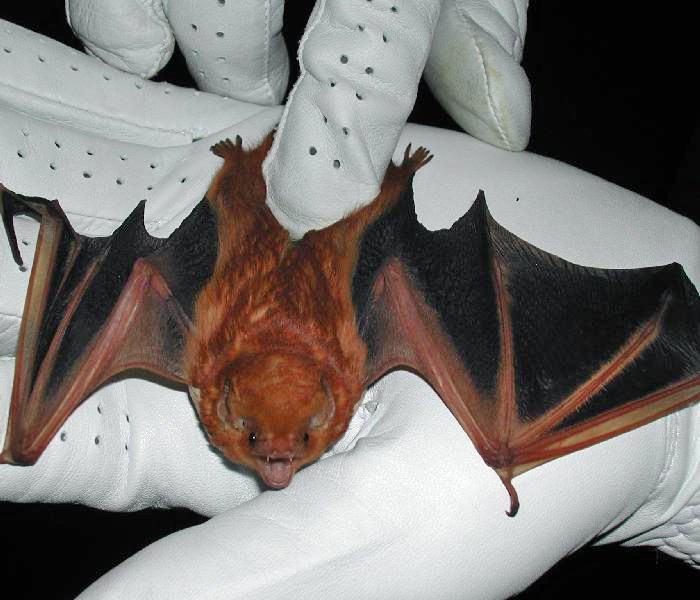Red Bats (Lasiurus borealis)

Key Takeaways
- Eastern Red Bats are found throughout North America and undertake long-distance migrations.
- They prefer to roost in forested areas with dense vegetation, and habitat loss negatively impacts their populations.
- Eastern Red Bats have physical characteristics such as a wingspan ranging from 9 to 11 inches and fur color varying from bright reddish-brown to dark chestnut.
- They are nocturnal hunters with a diverse diet, feeding on moths, beetles, flies, and mosquitoes.
Habitat and Distribution
The Eastern Red Bat (Lasiurus borealis) is found throughout a wide range of habitats in North America. This species exhibits unique migration patterns and population trends. Eastern Red Bats are known to undertake long-distance seasonal migrations. They migrate southward during the winter months, seeking warmer climates. This migration is believed to be driven by the scarcity of food and the need to avoid extreme cold temperatures. In the spring, they return to their northern breeding grounds.
The population trends of Eastern Red Bats are influenced by various factors. One key factor is habitat availability and quality. These bats prefer to roost in forested areas with dense vegetation, such as deciduous and mixed forests. The loss and fragmentation of suitable habitats due to urbanization, deforestation, and agricultural expansion have negatively impacted their populations.
Additionally, Eastern Red Bats are susceptible to threats such as predation, pesticide use, and wind turbines. These factors can further contribute to population declines. However, it is important to note that the Eastern Red Bat is considered a species of least concern by the International Union for Conservation of Nature (IUCN) due to its wide distribution and relatively stable populations. Continued monitoring and conservation efforts are crucial to ensure the long-term survival of this species.
Physical Characteristics
Eastern Red Bats possess a distinctively furred body with a wingspan ranging from 9 to 11 inches. They are small to medium-sized bats, weighing between 8 and 13 grams. The fur of Eastern Red Bats varies in color, ranging from a bright reddish-brown to a dark chestnut, with the underside often lighter in color. This coloration helps them blend in with the foliage, providing camouflage during roosting and hibernation periods.
Eastern Red Bats have a unique set of physical characteristics that aid in their flight behavior. They have long, narrow wings with pointed tips, allowing for agile and maneuverable flight. Their wings are covered in fine, velvety fur, which helps to reduce turbulence and noise during flight, enabling them to fly silently in pursuit of prey. Additionally, their wings are elongated and flexible, allowing for efficient and sustained flight over long distances.
While Eastern Red Bats possess excellent flight capabilities, they rely less on echolocation abilities compared to other bat species. Instead, they primarily rely on visual and auditory cues to navigate their surroundings. This allows them to locate and capture flying insects, their primary food source, while in flight.
Feeding Habits
Feeding primarily on flying insects, Eastern Red Bats rely on their visual and auditory cues to locate and capture prey during their agile flight behavior. These bats exhibit unique foraging behavior and have specific diet preferences that contribute to their survival and reproductive success. Here are three key aspects of their feeding habits:
- Nocturnal Foraging: Eastern Red Bats are nocturnal hunters, taking advantage of the abundant insect activity during the night. They are known to forage in a variety of habitats, including forests, meadows, and wetlands.
- Insect Diet Preferences: These bats have a diverse diet, feeding on a wide range of flying insects. Their diet preferences include moths, beetles, flies, and mosquitoes. They have been observed consuming both large and small insects, demonstrating their adaptability in capturing prey.
- Hawking Technique: Eastern Red Bats use a hawking technique to catch their prey. They fly low and slow, scanning the environment for potential prey items. Once they detect an insect, they swiftly change their flight trajectory, using their agile wings to maneuver and snatch the prey mid-air.
Reproduction and Life Cycle
During their reproductive cycle, Eastern Red Bats exhibit distinct behaviors and undergo specific physiological changes to ensure successful reproduction. Mating behavior in Eastern Red Bats is characterized by a promiscuous mating system, where males compete for females. Mating usually occurs in late summer or early fall, with females storing sperm until spring when ovulation and fertilization take place.
After mating, female Eastern Red Bats undergo a period of delayed implantation. This unique reproductive strategy allows the female to suspend the development of the fertilized egg until environmental conditions are favorable for rearing young. Once conditions improve, implantation occurs, and gestation lasts approximately 80 to 90 days.
Parenting strategies in Eastern Red Bats are primarily maternal. Females give birth to one or two pups, typically in late spring or early summer. The pups are born fully furred and with their eyes open. The mother carefully roosts with her young, providing warmth and protection. She nurses them with her nutrient-rich milk until they are capable of foraging on their own.
As the pups grow, they begin to accompany their mother on foraging flights, gradually developing their own hunting skills. By late summer or early fall, young Eastern Red Bats become independent and start their own reproductive cycle, continuing the life cycle of this remarkable species.
Conservation Status
The conservation status of the Eastern Red Bat is regularly assessed to monitor the population trends and ensure the species’ long-term survival. Several threats to the population exist, including habitat loss, pesticide use, and disturbance during hibernation. Conservation efforts are being implemented to mitigate these threats and protect the Eastern Red Bat:
- Habitat conservation: Protecting and restoring the natural habitats of the Eastern Red Bat is crucial for its survival. Efforts are underway to conserve and manage forests, wetlands, and other habitats where the species can roost and forage for insects.
- Education and outreach: Raising awareness about the Eastern Red Bat and its importance in the ecosystem is essential for its conservation. Educational programs, public campaigns, and outreach initiatives aim to engage the public, landowners, and policymakers in conservation efforts.
- Monitoring and research: Regular monitoring of the Eastern Red Bat population helps assess its status and identify any changes or emerging threats. Research projects focus on understanding the species’ ecology, migration patterns, and habitat requirements to inform conservation strategies.
Bat Species
Rafinesque’s big-eared bat (Corynorhinus rafinesquii)
Silver-haired bat (Lasionycteris noctivagans)
Seminole bat (Lasiurus seminolus)
Little brown bat (Myotis lucifugus)
Indiana bat (Myotis sodalis)
Virginia big-eared bat (Corynorhinus townsendii virginianus)
Gray bat (Myotis grisescens)
Eastern small-footed myotis (Myotis leibii)
Evening bat (Nycticeius humeralis)
Big brown bat (Eptesicus fuscus)
Hoary bat (Lasiurus cinereus)
Southeastern myotis (Myotis austroriparius)
Northern bat (Myotis septentrionalis)
Eastern pipistrelle (Pipistrellus subflavus)
Bat Related Diseases
Histoplasmosis
Rabies
White-Nose Syndrome
Nuisance Bat Topics
Frequently Asked Questions
What does an Eastern Red Bat look like?
Eastern Red Bats have distinctive fur, with males being brick or rusty red, and females being a slightly more frosted shade of red. Both male and female eastern red bats have distinctive shoulder patches of white fur. They are medium-sized, weighing 7–13 g (0.25–0.46 oz) and measuring 109 mm (4.3 in) from head to tail. Their ears are short and rounded, with triangular tragi, and their wings are long and pointed. Their entire body is densely furred, including their uropatagium[2][4].
Where do Eastern Red Bats live?
Eastern Red Bats are widespread across eastern North America, with additional records in Bermuda. They generally occur east of the Continental Divide, including southern Canada and northeastern Mexico. In the spring and summer, they can be found in the Great Lakes region and the Great Plains region. In the winter, they migrate to the southeastern United States and northeastern Mexico, where they typically frequent coastal areas[4].
What is the behavior of Eastern Red Bats?
Eastern Red Bats are solitary creatures that come together only to mate and to migrate. During the day, they usually hang on tree branches wrapped in their furry tail membranes resting or sleeping, and at nightfall, they set off to hunt. They are known to fly relatively quickly and are moderately maneuverable, especially when catching insects “on the wing”[4].
What do Eastern Red Bats eat?
Eastern Red Bats are insectivorous, preying heavily on moths, with other insect taxa also consumed. They consume known pests, including gypsy moths, tent caterpillar moths, Cydia moths, Acrobasis moths, cutworm moths, and coneworm moths[3].
What is the conservation status of Eastern Red Bats?
Eastern Red Bats are North America’s most abundant “tree bats.” They are found wherever there are trees east of the Rocky Mountains, from Canada to as far south as central Florida. They are known to survive body temperatures as low as 23 degrees F. Their long, silky fur provides extra protection from severe cold, and they also use their heavily furred tail membrane like a blanket, wrapping themselves up almost completely[3].
Citations: [1] https://crittercontroloftampa.com/blog/questions-about-bats-youve-always-wondered/ [2] https://en.wikipedia.org/wiki/Eastern_red_bat [3] https://www.batcon.org/bat/lasiurus-borealis/ [4] https://animalia.bio/eastern-red-bat [5] https://dwr.virginia.gov/wildlife/information/eastern-red-bat/

